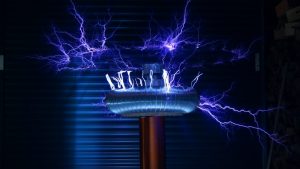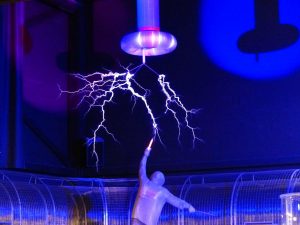See the mini-explosions and experiments of Nikola Tesla, get lost in the mirror maze and feel like a spy in the room with lasers, split a protein, dig up a skeleton and create a giant soap bubble – all this can be done in the most unusual museum of Kyiv “Experimentanium”.
For five years, he received visitors in Podil, and four months ago, it became cramped in the old premises, and he moved to a new, spacious pavilion on Petrivka. About how children and the museum itself have changed over the years, how often exhibits have to be repaired and what Ukrainian schools should learn from the “Experimentanium”, Oleg Stasiuk, deputy director for scientific development, told.
Interactive museums must constantly evolve and change, otherwise people simply stop visiting them. It became impossible to accommodate anything new in Podil, and here there is much more space for new exhibitions. One of the new ones is the “Secret of Water” zone, we plan to replenish it. So far, the most popular here is to make a water tornado and soap bubbles. There are also some ideas for creating a permanent lecture hall and launching new educational shows.
There are exhibits that we invent ourselves, and there are those that we spy in other science museums. “Water Balance” had no analogues when we launched it. There were devices that make different measurements, but we decided to combine them into one. “Pythagorean pants” were spotted on the Internet. But we make everything ourselves.
Exhibits break very often, which is not surprising, considering how many children come to us. There are exhibits that we repair almost every day.
The Time Mirror first broke 20 seconds after launch. The child simply took a metal ball and threw it at the screen. Only after that we thought about the protective coating and testing before launch. Testing usually goes like this: we launch a group of children into the exhibit and see if something breaks, then we refine this element.
Yes, you can touch everything in our museum, but we must warn accompanying adults that they are responsible for the health of children and damage to exhibits. Of course, we have guides who monitor this, but when there are 500 children in the museum at the same time, it is quite difficult.

The most popular exhibits
Mirror maze
You enter a corridor with mirrors and try to find a way out of it
Laser maze
A room riddled with laser lines, from which you need to quickly get out without touching the lasers.
“White”
A game where you need to use enzyme balls to split protein into amino acids
Sandbox
An interactive sandbox in which the program recognizes areas of sand of different heights and sends a picture simulating a topographic map to the projector
Reaction speed
You need to quickly press the buttons that light up: this is how you can determine the speed of information processing by each person’s brain
There are basic things, fundamental laws of physics that will always work. To illustrate them, we use both long-known things – optical illusions, mechanisms with blocks, and new ones – 3D computer, interactive screens, Kinnect technology.
People come to us from different regions. Recently, people from Kherson region came to the chemical show.
I meet parents who first brought their eldest son, and after a few years already brought their youngest. Sometimes they say: “Do you remember when we went to your chemistry club? The boy has now entered the chemistry faculty.” Of course, the influence of the “Experimentanium” was minimal, it is still the work of the child and parents, but we still gave some impetus.
In institutions like ours, it is very important to maintain a balance between entertainment and science. Children, first of all, come to have fun, but there is no less science in our exhibits, because every exhibit, even the simplest, demonstrates some physical phenomenon or process.
Of course, studies at the “Experimentanium” and at school are different. School education in Ukraine lacks interactivity and visibility – that’s obvious. Children are not interested in simply absorbing information and then retelling it. It is also worth paying attention to integration, combining lessons – geography, physics, chemistry, biology, in order to understand the relationships between them.

Our museum is a hint that the lesson can be conducted in a different way.
There is a difference between how children of different ages perceive exhibits.
A five-year-old child will look at a “colored shadow” and say “wow, that’s a colored shadow.”
At the age of twelve, she can already go to art school and draw, then she will say: “if we combine yellow and blue, we will get green – everything is correct.”
At the age of sixteen, she might remember that these are spectra: “I think that’s what they said in physics: first the color violet, then green, and then the wavelength increases and our eye no longer sees that huge wave in the form of infrared.”
In five years, it is noticeable how the children have changed. It is difficult for them to keep their attention, they are very distracted. Perhaps this is due to the fact that almost every child now has a smartphone. But that’s not bad either. Every day, the child receives a lot of different information and chooses what is interesting to him. So it is with the exhibits: before, children could calmly listen to an hour-long tour, but now they choose a few of the most interesting exhibits for them and want to learn more about them. They have enough general information about the rest of the exhibition.
